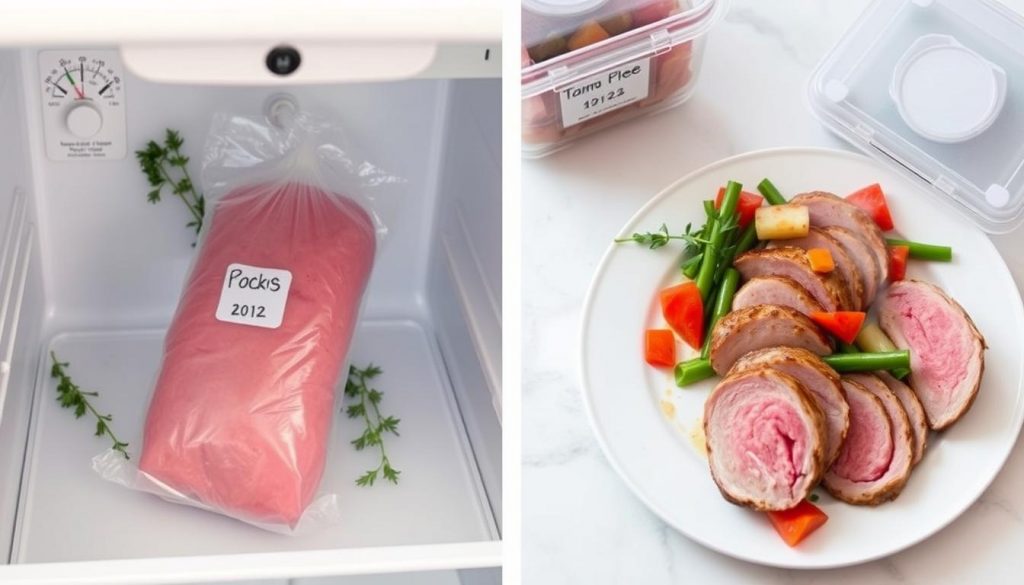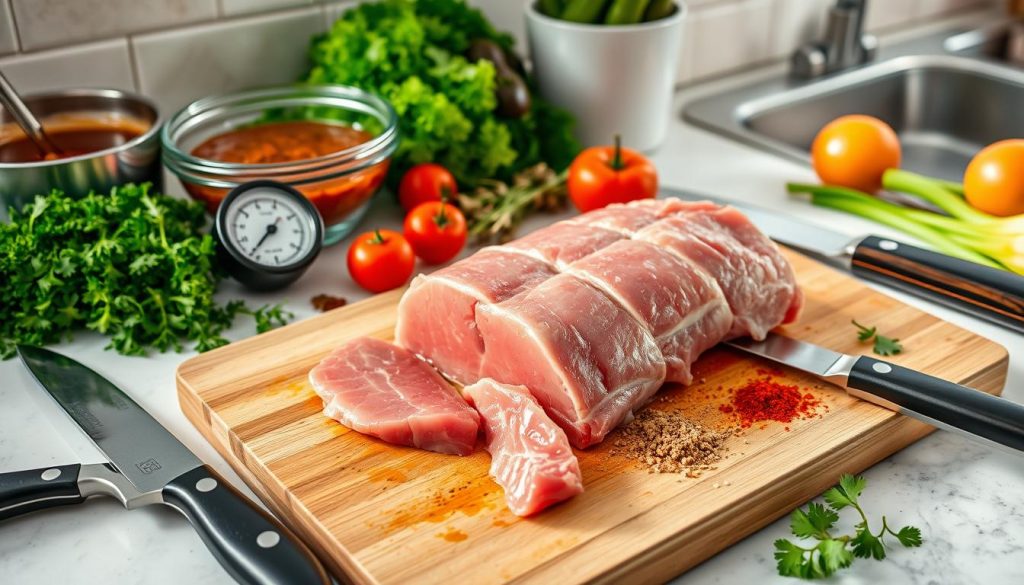Pork tenderloin is a lean, tasty cut perfect for various dishes. Proper fridge storage is vital for food safety and meat quality. This guide covers essential storage tips for pork tenderloin.
Good storage methods can greatly improve your pork tenderloin’s quality and safety. We’ll explore how to keep your meat fresh from purchase to cooking time.
Key Takeaways
- Proper pork tenderloin storage is essential for food safety
- Refrigerator temperature plays a key role in meat freshness
- Packaging and placement affect storage duration
- Visual and smell cues help identify spoilage
- Different storage rules apply for raw and cooked pork
- Freezing is an option for long-term storage
Understanding Pork Tenderloin Storage Basics
Pork tenderloin is a unique cut that needs special care. Proper storage keeps it fresh and tasty longer. Let’s explore how to store this lean meat effectively.
What Makes Pork Tenderloin Different
Pork tenderloin is prized for its leanness. It lacks a protective fat layer, making it prone to drying out. This lean cut also easily absorbs odors.
Extra care in storage is necessary to maintain its quality. Proper handling ensures the best flavor and texture.
Optimal Storage Temperature
Store pork tenderloin between 32°F and 38°F (0°C to 3°C). This temperature range slows bacterial growth without freezing the meat. Consistent temperature is crucial for preserving freshness.
The Role of Proper Packaging
Effective packaging is key to food preservation. We recommend using airtight containers or vacuum-sealed bags for pork tenderloin. These methods protect the meat from air exposure and prevent oxidation.
Proper wrapping also stops cross-contamination with other foods in your fridge. It helps maintain the meat’s quality and safety.
- Use plastic wrap or aluminum foil for short-term storage
- Opt for vacuum-sealed bags for longer shelf life
- Place wrapped tenderloin in a sealed container for extra protection
These storage basics will help extend your pork tenderloin’s life. You’ll keep its quality and flavor intact for longer periods.
How Long Does Pork Tenderloin Last in the Fridge
Pork tenderloin is a tasty, versatile cut of meat. Managing its shelf life can be tricky. Let’s explore how long you can safely store this lean cut.
Raw pork tenderloin stays fresh for 3-5 days in the fridge. Store it properly to plan meals without risking food safety. Cooked pork tenderloin lasts 3-4 days in the refrigerator.
To keep your pork fresh longer, try these tips:
- Keep your fridge temperature at or below 40°F (4°C)
- Store pork in the coldest part of your refrigerator
- Use airtight containers or wrap tightly in plastic wrap or aluminum foil
- Place pork on a plate or in a shallow dish to catch any drips
These timeframes are just guidelines. Always check for signs of spoilage before eating. If it smells off or looks slimy, toss it out.
“When in doubt, throw it out. It’s better to be safe than sorry when it comes to meat storage.”
Proper storage techniques help you enjoy pork tenderloin at its best. Follow these tips to keep your meat fresh and safe. Your taste buds and health will thank you!
Signs of Fresh vs. Spoiled Pork Tenderloin
Spotting fresh from spoiled pork tenderloin is vital for safe eating. Let’s explore key signs of meat spoilage and learn how to assess pork quality.
Visual Indicators of Freshness
Fresh pork tenderloin should be pinkish-red with some marbling. It should look moist but not slimy. Be wary of discoloration, mold, or too much moisture.
Smell and Texture Changes to Watch For
Good pork has a mild, slightly sweet scent. Sour, ammonia-like, or rotten smells mean it’s likely bad. The meat should feel firm and springy when touched.
Sticky or slimy surfaces suggest bacteria are growing. If you notice these signs, it’s best to toss the pork.
Color Changes That Signal Spoilage
Pork changes color as it goes bad. Watch out for grayish-brown hues, green or blue spots, or dark brown areas.
- Grayish-brown hues
- Green or blue spots
- Dark brown discoloration
These color shifts clearly show meat spoilage. If you’re unsure, it’s safer to throw the pork away.
Proper storage and handling are key to keeping pork fresh. This ensures food safety and maintains the meat’s quality.
Raw vs. Cooked Storage Guidelines
Proper storage is vital for meat preservation. Raw and cooked pork have different storage needs. Let’s explore these guidelines to keep our meals safe and delicious.

Raw pork tenderloin needs special attention. Store it on the bottom shelf of your fridge. Use it within 3-5 days of buying. Wrap it tightly or use an airtight container to prevent drips.
Cooked pork storage differs slightly. Leftovers can last 3-4 days in the fridge. Cool it quickly and use shallow containers. This helps it reach a safe temperature faster.
| Storage Type | Fridge Duration | Storage Tips |
|---|---|---|
| Raw Pork | 3-5 days | Bottom shelf, tightly wrapped |
| Cooked Pork | 3-4 days | Shallow containers, cool quickly |
Always check for spoilage before eating pork. If it smells odd or looks slimy, throw it out. Trust your senses when deciding.
Following these rules helps us enjoy pork safely. It also reduces food waste. Proper storage keeps our meals tasty and fresh.
Best Practices for Refrigerating Pork Tenderloin
Storing pork tenderloin correctly keeps it fresh and safe. Let’s look at the best ways to store meat and keep pork tasty.
Proper Wrapping Techniques
Wrap pork tenderloin tightly in plastic wrap or aluminum foil. This keeps air out and the meat moist. For extra protection, add a layer of butcher paper.
Container Selection Tips
Pick airtight, leak-proof containers to stop juices from spilling. Glass or BPA-free plastic containers work great. Choose a container that fits the pork snugly.
Placement in Refrigerator
Put wrapped or contained pork on the bottom shelf of your fridge. This area is usually coldest. It also stops drips from getting on other foods.
| Storage Method | Advantages | Best For |
|---|---|---|
| Plastic Wrap | Tight seal, prevents freezer burn | Short-term storage |
| Airtight Containers | Stackable, prevents odor transfer | Cooked pork, longer storage |
| Vacuum Sealed Bags | Extends shelf life, saves space | Long-term storage, raw pork |
These tips will help your pork tenderloin last longer and taste better. Good storage is key to great pork dishes. Enjoy your perfectly stored pork!
Extending Shelf Life Through Proper Handling
Proper handling of pork tenderloin is vital for food safety and quality. Let’s look at key steps to extend its shelf life. We’ll focus on food handling safety and kitchen hygiene practices.
Initial Preparation Steps
Start with clean hands and sanitized surfaces when preparing pork tenderloin. Rinse the meat under cold water and pat it dry with paper towels. This step removes surface bacteria and prepares the meat for cooking or storage.

Temperature Control Methods
Temperature control is crucial in meat preparation. Keep pork tenderloin refrigerated at 40°F (4°C) or below. Use a meat thermometer when cooking to ensure it reaches 145°F (63°C) internally.
After cooking, cool it quickly by dividing into smaller portions before refrigerating. This helps maintain food safety and quality.
Cross-contamination Prevention
To maintain kitchen hygiene and prevent cross-contamination:
- Use separate cutting boards for raw meat and other foods
- Wash utensils thoroughly after contact with raw pork
- Store raw pork on the bottom shelf of the fridge to prevent drips onto other foods
These guidelines can significantly extend the shelf life of pork tenderloin. Proper meat preparation and storage are key to maintaining quality and safety in your kitchen.
Freezing Options for Long-term Storage
Freezing pork extends its shelf life. We’ll cover best practices for storing meat in your freezer. Proper freezing keeps pork safe and tasty for months.
Wrap pork tenderloin tightly in plastic wrap or aluminum foil. Place it in a freezer-safe bag, removing as much air as possible. This double-wrapping prevents freezer burn and maintains quality.
Set your freezer to 0°F (-18°C) or below for optimal safety. At this temperature, pork tenderloin stays fresh for up to 6 months.
Proper thawing is crucial when using frozen pork. The safest method is refrigerator thawing. This can take 24 to 48 hours for a pork tenderloin.
| Storage Method | Temperature | Storage Time |
|---|---|---|
| Refrigerator | 40°F (4°C) | 3-5 days |
| Freezer | 0°F (-18°C) | Up to 6 months |
Freezing stops bacterial growth but doesn’t kill bacteria. Handle pork safely before freezing and after thawing. This ensures food safety throughout the process.
Thawing Methods and Safety Guidelines
Safe meat thawing is vital for food quality and preventing bacteria growth. We’ll explore three effective methods for defrosting pork. These methods ensure you follow proper food safety practices.
Refrigerator Thawing Process
The safest way to thaw pork tenderloin is in the refrigerator. Place the frozen meat on a plate to catch drips. Allow about 24 hours for every 5 pounds of meat.
This slow process keeps the pork at a safe temperature throughout defrosting.
Cold Water Thawing Technique
For quicker results, try the cold water method. Seal the pork in a leak-proof plastic bag. Submerge it in cold tap water.
Change the water every 30 minutes to maintain a cold temperature. Small packages may thaw in an hour. Larger ones can take 2-3 hours.
Microwave Thawing Safety
Microwave thawing is the fastest option but requires immediate cooking afterward. Remove all packaging. Place the pork on a microwave-safe dish.
Use the defrost setting or 50% power. Rotate and flip the meat often for even thawing.
Remember, proper handling of pork is essential for food safety. Never thaw meat on the counter. This can lead to bacterial growth.
Always cook thawed pork promptly to ensure it’s safe to eat.
| Thawing Method | Time Required | Safety Level |
|---|---|---|
| Refrigerator | 24 hours per 5 lbs | High |
| Cold Water | 1-3 hours | Medium |
| Microwave | Minutes | Low (requires immediate cooking) |
Food Safety Tips for Pork Storage
Proper pork storage is vital to avoid foodborne illnesses. Here are key USDA guidelines for safe pork handling and storage.
USDA Guidelines
USDA offers thorough meat handling guidelines to ensure food safety. These cover storage temps, cooking methods, and handling practices.
The guidelines aim to reduce contamination risks. Following them helps keep your pork safe to eat.
| Storage Type | Temperature | Maximum Storage Time |
|---|---|---|
| Refrigerator | 40°F (4°C) or below | 3-5 days |
| Freezer | 0°F (-18°C) or below | 4-6 months |
Temperature Danger Zone
The temperature danger zone is crucial in preventing foodborne illness. Bacteria grow fast between 40°F and 140°F (4°C and 60°C).
Keep pork out of this range to lower contamination risk. This simple step can greatly improve food safety.
Safe Handling Practices
Follow these steps to keep pork safe and tasty:
- Wash hands thoroughly before and after handling raw pork
- Use separate cutting boards for raw meat and other foods
- Clean all utensils and surfaces that come into contact with raw pork
- Cook pork to a minimum internal temperature of 145°F (63°C)
- Refrigerate or freeze pork within two hours of purchase or cooking
These USDA guidelines help prevent pork-related foodborne illnesses. By following them, you can enjoy safe and delicious pork dishes.
Common Storage Mistakes to Avoid
Storing pork tenderloin can be tricky. Let’s explore common meat storage errors and how to avoid them. These tips will help you become a pro at keeping your pork fresh.
Poor packaging is a major mistake. Always use airtight containers or wrap tightly in plastic or foil. This simple step keeps your meat fresh longer.
Temperature fluctuations can spoil your pork. Limit how often you open your fridge door. When you need the meat, grab it quickly and close the door.
Cross-contamination is another risk to watch out for. Keep raw pork on the bottom shelf, away from other foods. This prevents harmful bacteria from spreading in your fridge.




